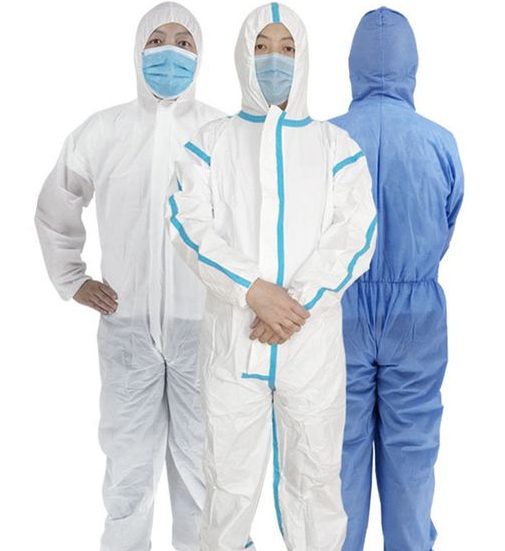In high-risk industries, choosing right disposable PPE (personal protective equipment) is crucial for maintaining safety and health standards. This guide provides seven essential tips to help industries, from healthcare to manufacturing, select the most effective PPE for their specific needs. By following these tips, employers can ensure maximum protection, compliance with safety regulations, and overall operational efficiency.
What is The Choosing Right Disposable PPE?
Disposable PPE
Disposable PPE (Personal Protective Equipment) refers to protective gear designed for single-use only, which is discarded after it is no longer effective or has been damaged. These devices are used in hazardous work environments to protect workers from harmful agents such as bacteria, viruses, chemicals, dust, and other potential hazards. Disposable PPE products include masks, gloves, gowns, face shields, and other protective equipment.
Disposable PPE is typically made from materials like polypropylene, polyethylene, or non-woven fabrics to create products that provide strong protection while being lightweight and comfortable for the user. These devices prevent direct contact with harmful agents and do not require cleaning or disinfecting after each use.
Choosing Right Disposable PPE
Choosing right disposable PPE is critical to ensuring that the level of protection matches the risks in a specific environment. The proper selection depends on the nature of the job, the type of hazard, and the applicable regulations in the industry. Factors such as comfort, durability, and compliance with industry standards should all be considered when choosing right PPE for workers.
Benefits of Choosing Right Disposable PPE
Choosing right disposable PPE brings many benefits, from protecting the health of employees to ensuring safety compliance and reducing risks in the workplace.
Protecting Health and Safety
Selecting the right PPE helps protect workers from workplace hazards such as bacteria, viruses, chemicals, or fine dust particles. Using appropriate PPE reduces the risk of occupational diseases, injuries, or serious health conditions caused by exposure to hazardous factors.
Compliance with Safety Regulations and Standards
Using the right PPE also helps businesses comply with safety regulations and industry standards, such as OSHA, NIOSH, or ASTM requirements. These standards set specific criteria for protection levels and the quality of PPE, helping to safeguard not only employees but also the company from legal and financial consequences.
Reducing Long-Term Costs
Although the initial cost of disposable PPE may be higher, making the right choice can reduce long-term expenses. Correct PPE usage minimizes the need for replacement and prevents ineffective use, while also helping avoid medical costs or fines related to non-compliance with regulations.
Improving Work Efficiency and Comfort
When chosen correctly, disposable PPE not only protects but also provides comfort for the wearer. Suitable protective gear does not interfere with movement or work tasks, which enhances performance and focus on the job.
Environmental Protection and Sustainability
While disposable PPE can generate a significant amount of waste, eco-friendly options such as biodegradable or recyclable PPE are becoming increasingly available. Choosing these products helps businesses minimize their environmental impact and contribute to sustainability initiatives.
7 Essential Tips for Choosing Right Disposable PPE
Identify Industry-Specific PPE Requirements
Each industry has unique safety standards and guidelines for disposable PPE. For example, healthcare workers require PPE such as masks, gowns, and gloves to protect against infectious agents, while construction and manufacturing industries need equipment like disposable coveralls and masks to protect against dust and chemicals.
To meet these requirements, consult industry standards such as the OSHA guidelines or specific mandates from your industry’s regulatory bodies. These resources often outline minimum PPE standards, making them valuable references when deciding which disposable PPE best meets your industry’s specific needs.
Consider the Level of Protection Needed
Disposable PPE comes in various types and grades, each offering different levels of protection. The level of protection required will depend on the risks present in your work environment:
- Minimal exposure (e.g., dust or minor splashes): Lightweight gloves or masks might suffice.
- Moderate exposure (e.g., handling chemicals): Requires more durable PPE like chemical-resistant gloves.
- High-risk environments (e.g., exposure to infectious diseases or hazardous substances): Full protective gear, including masks, gowns, and face shields, is essential.
Selecting the correct level of protection is critical to ensure worker safety without overusing resources or reducing mobility. For instance, healthcare environments often require Level 2 or Level 3 gowns according to ASTM standards.
Check Compliance with PPE Standards
Choosing right disposable PPE that meets recognized standards is crucial for safety and regulatory compliance. Various international standards such as EN 14126 for protective clothing in medical use or NIOSH standards for masks provide guidelines on the quality and performance of PPE.
- Masks: Should meet standards like NIOSH’s N95 or ASTM Level 2/3.
- Gloves: Medical gloves should adhere to standards like ASTM D6319.
- Gowns: Choose gowns that meet the requirements for fluid resistance and tensile strength, especially for high-exposure settings.
Following these standards ensures that you’re not only compliant but also equipped with the best protective gear to handle industry-specific risks.
Evaluate Material and Comfort of PPE
Comfort is a significant factor in PPE selection, as uncomfortable equipment can hinder worker performance and compliance. Disposable PPE is available in different materials, each with specific advantages:
- Polyethylene: Commonly used for disposable aprons and gowns, this material offers strong resistance to liquids.
- Non-woven fabrics: Lightweight and breathable, ideal for extended use without causing discomfort.
- Latex or nitrile: Preferred for gloves due to their elasticity and resistance to punctures.
For prolonged use, prioritize lightweight and breathable materials, especially in hot or enclosed work environments. Properly fitting PPE is also crucial to avoid skin irritation and improve mobility, which enhances both comfort and compliance.
Opt for Environmentally-Friendly PPE Options
Disposable PPE often generates a significant amount of waste, especially in industries with high consumption rates. Opting for environmentally-friendly options can minimize the environmental impact:
- Biodegradable PPE: Some gloves, masks, and gowns are now made from biodegradable materials, which break down more easily in landfills.
- Recyclable materials: PPE made from recyclable components can be properly disposed of and repurposed.
- Reusable PPE: In some cases, reusable PPE might be preferable if it can be disinfected and sterilized effectively.
Choosing eco-friendly PPE not only aligns with global sustainability goals but also positions your company as an environmentally responsible organization.
For more information on sustainable PPE options, consider the World Health Organization’s guidance on PPE waste reduction.
Train Employees on Correct PPE Usage
Proper usage is key to PPE effectiveness. Workers need training to understand:
- When and how to wear each type of PPE.
- Correct donning and doffing procedures to avoid self-contamination.
- Limitations of disposable PPE, including its intended single-use design.
Training also includes understanding disposal protocols, as improper handling of used PPE can expose others to contaminants. Regular training sessions reinforce safe practices and ensure that employees understand the importance of using PPE correctly to maximize protection.
Check out CDC’s PPE training resources for comprehensive guidelines and materials.
Assess the Cost and Longevity of Disposable PPE
Balancing cost and quality is essential for industries needing large volumes of PPE. While budget constraints are important, compromising on quality for a lower price can lead to safety risks, higher replacement costs, and potential penalties for non-compliance.
When evaluating cost, consider:
- Bulk purchasing: Many suppliers offer discounts on large orders, making it cost-effective for high-usage industries.
- Supplier reliability: Choose suppliers with consistent quality standards and a strong reputation.
- Product durability: High-quality PPE often lasts longer and provides more reliable protection, reducing the need for frequent replacements.
Selecting durable, compliant PPE ensures worker safety and can reduce overall expenses related to PPE usage over time.
TM&DV 8688 Co., Ltd. – Leading PPE Supplier in Vietnam
When it comes to choosing and supplying disposable personal protective equipment (PPE), TM&DV 8688 Co., Ltd. is one of the most trusted partners in Vietnam. With years of experience and a commitment to quality, TM&DV 8688 specializes in providing PPE that meets international standards, catering to a wide range of protective needs across sectors such as healthcare, industry, and industrial cleaning.
The company focuses on offering high-standard protective products, including coveralls, safety vest, apron, boot, shoe covers, and protective gowns. TM&DV 8688 not only provides high-quality products but also prioritizes customer support, offering consultation services to help clients select the most suitable PPE for their specific requirements and working conditions.
If you’re seeking PPE solutions for your business, explore more at TM&DV 8688 Co., Ltd. to discover a diverse product portfolio and a range of supportive services provided by the company.
Conclusion
Choosing right disposable PPE wisely is critical for maintaining safety, compliance, and efficiency across various industries. By carefully assessing your industry’s requirements, selecting PPE with the right level of protection, ensuring compliance, and prioritizing comfort, you can create a safer workplace. Additionally, choosing eco-friendly and cost-effective options aligns with sustainability goals and financial considerations, while proper training ensures that employees use PPE effectively. With these essential tips, your industry can confidently select the best disposable PPE to meet both regulatory and operational demands.

